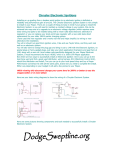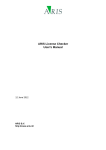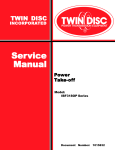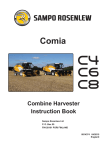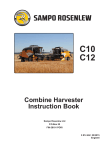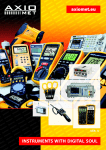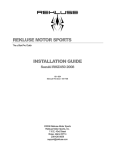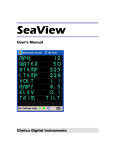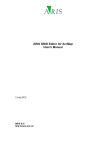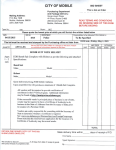Download Group 6 - Clutch
Transcript
CLUTCH 6-1 GROUP 6 CLUTCH CONTENTS Page Specifications. . . . . . . . . . . . . . . . . . . . . . . . . . . . . . . . . Special Tools. Torque Reference Clutch Adjustment. Clutch Pedal Free Play Pa§* 1 1 1 2 2 Transmission Main Drive Pinion Pilot B u s h i n g . . . . . . . . . Clutch Release Bearing Torque Shaft and B e a r i n g s . . . . . . . . . . . . . . . . . . . . . . Clutch Housing Alignment. Clutch installation Service Diagnosis 5 6 6 6 7 8 SPECIFICATIONS CLUTCH Make.....................:... Model Vehicle Model Application . Engine Size. Transmission Type. . . . . . . V . . . . . . . . . . . . . . . . CLUTCH DISC Facing Type. Outside Diameter. . Thickness. Disc Springs (number) Disc Spring Color. Borg & Beck 1506 VC-1 Borg & Beck 1579 *VC-2 with optional 413 cu. in. engine 361 cu. in. 383 cu. in. 413 cu. In. Standard 3-Speed or 4 Forward Speed Manual Transmission 10 / " .125" 10 5 Green 5 Tan Moulded Woven Asbestos lO'/a" .125" 10 5 Green 5 Tan 11" .125" 10 5 Green 5 Tan 9 6 No Color 3 White 185 ea. 233 ea. 12 6 Orange 6 No Color 162 ea. 185 ea. 12 6 White 6 Orange 233 ea. 162 ea. 1920 3 2" 20 2205 3 2" 20 Va" 2490 3 2" 19 ! 2 . CLUTCH COVER Pressure Springs (number) Spring Color. . . Spring Pressure (lbs.). Total Spring Pressure (Ibs.@l /2") Number of Levers Height from Face of F l y w h e e l . . . . . . . . . . Lever Setting Gauge Number Pedal Free Play (at clutch fork) *Used with 360 and 390 FirePower Engines. ! Borg & Beck 1570 VC-2 SPECIAL T O O L S C-41 DD-286 C-360 C-585B Pilot Bushing Remover Bushing Installer and Burnisher Aligning Arbor Clutch Rebuilding Fixture C-647. . . . . . . . . S p r i n g Testing Fixture C - 8 6 0 . . . . . . . . Reamer C-869. . . . . . . . Housing Aligning Gauge C-3005........Torque Wrench TORQUE TIGHTENING Foot-Pounds Clutch Housing to Engine Bolts. .,. Clutch Cover to Flywheel Bolts (%") (Used with 360 and 390 FirePower Engines). Clutch Pan Bolts Clutch Fork Pivot B o l t s . . . . . . . . . . Flywheel Bolt Nut. . ... .......... ..... Transmission to Clutch Housing Bolts. Torque Shaft Pivot (engine side) Torque Shaft Pivot Bracket Bolts (frame side) ? . ........ .... 30 30 100 Inch-Pounds 15 60 50 40 15 CLUTCH 6-2 CLUTCH The semi-centrifugal clutch combines the feature of low pedal effort with that of a clutch capable of transmitting the full torque of the engine. Six cylindrical rollers, located in the pressure plate, are free to move outward under centrifugal force until they contact the cover, as shown in Figure 1. As engine speed increases the rollers act as wedges between the cover and the pressure plate. The faster the clutch revolves, the greater the pressure on the plate. The greater pressure increases the normal load on the disc assembly. SERVICE PROCEDURES 1 . CLUTCH ADJUSTMENT ( I n The Vehicle) 3. The only adjustment required while the clutch is in the vehicle, is linkage adjustment to obtain the correct amount of clutch pedal free play. The clutch pedal free play is the movement of the pedal required to close the clearance between the throwout bearing and the clutch fingers. The linkage adjustment is required to restore the pedal free play when it has been reduced by the ^normal wear of the clutch (Fig. 2). > Removal CLUTCH (1) Remove the transmission. See "Manual Transmission" Group 21 for detailed procedure. (2) Remove the clutch housihg pan and the dust seal. (3) Disconnect the release fork rod at the release fork. (4) Remove the release fork pull back spring. (5) Detach the release fork from its pivot and remove the fork, dust seal, sleeve and the bearing. 2 . CLUTCH PEDAL FREE PLAY (6) Mark the flywheel, the clutch cover and one pressure plate lug to maintain their same relative positions during reassembly and instaUation. Shorten or lengthen the clutch release fork rod by turning the adjusting nut until there is % inch free movement of the clutch fork outer end. This adjustment if correctly set, will give the necessary 1 (one) inch free play at the pedal. 2 (7) Loosen and back off the attaching bolts a turn or two at a time in rotation to avoid bending the PLATE COVER PRESSURE SPRING ROLLER RELEASE BEARING SLEEVE PIN EYEBOLT // \ \J \ N RELEASE LEVER ^STRUT EYEBOLT NUTS RELEASE LEVER SPRING 60x70 Fig. 1—Semi-Centrifugal Clutch (Disassembled View) CLUTCH 6-3 SPRING SEAL BEARING—(2) BRAKE ASSY. DASH PANEL NUT & L.W. ASSY. (2) SPACER ASSY. SHAFT / PAD CLUTCH PEDAL ASSY. NUT-(2) PEDAL STOP BOOT L.W.-(2) SCREW—(2) 62x45B Fig. 2—Clutch Pedal Linkage (Disassembled View) flange of the cover. The disc facings should not be handled or placed in contact with grease, oil or dirt. Cover Disassembly (1) Place the cover assembly on the adjusting fixture, Tool C-585A. (2) Place the three-legged spider over the center screw, so that the legs are located midway between the staked nuts. Install the thrust washer and compression nut. Tighten the nut until the cover contacts the base of the fixture (Fig. 3). (3) Remove the three eye-bolt nuts, then remove the compression nut, washer and spider. (4) Remove the clutch cover, the springs and the rollers. (5) To remove the levers (Fig. 4), grasp the eyebolt CLUTCH PRESSURE PLATE CLUTCH COVER 45x452 Fig. 3—Clutch Cover and Pressure Plate Assy, in Fixture ^ Fig. 4—Removing Release Lever 6-4 CLUTCH between the thumb and index finger to hold it up I against the lever while the other fingers raise the lever up. With the other hand, lift the strut over the ridge on the end of lever. Lift the lever and eye bolt off the pressure plate and remove the strut. C l e a n i n g , Inspection and Testing (1) Use compressed air to clean the dust out of the clutch housing. Inspect for leakage through the engine rear main bearing <?il seal. If leaking, it should be corrected at this time. v (2) The back face of the flywheel should have a :; uniform appearance throughout the entire clutch contact area. If there is evidence of heavy contact on one portion of the wear circle and a very light contact 180° from that portion, the flywheel may be improperly mounted or sprung. In such cases, a dial indicator, mounted on the clutch housing with the plunger in contact with the wear circle, should show no more than .003 inch runout throughout a complete rotation of the flywheel. (3) The friction face of the flywheel should also be free from discolored, burned areas, small cracks and excessive grooves or ridges. (4) The bushing in the end of the crankshaft should be smooth and show no excessive wear. A new transmission main drive pinion or bushing driver and burnisher, Tool C-3181, can be used to gauge the size of the bushing. The tool should have a snug fit in the bushing. See Paragraph 4 on "Pinion Pilot Bushing Replacement." (5) The end of the transmission main drive pinion should be smooth and bright, without grooves and ridges. (6) The disc assembly should be handled without touching the facings. Replace facings that show evidence of grease or oil soakage or that are worn to within less than y inch of the rivet heads. The hub splines aiid the splines on the transmission main drive pinion should be a snug fit without signs of excessive wear. The metallic portions of the assembly should be dry and clean and should show no evidence of having been hot. Each of the arched springs between the facings should be unbroken and all rivets should be tight. (7) Clean all parts of the pressure plate and cover assembly in kerosene, mineral spirits or other similar solvents. plate lugs, in the marked location. The pressure plate friction area should be flat within .005 inch and should be free from discolored burned areas, cracks, grooves or ridges. (9) The eyebolts should be a snug but free fit in the pressure plate. (10) The rollers and the lugs of the pressure plate should not show excessive wear. The three sections of each roller should be free on the pin and free to revolve independently. (11) The inner ends of the release levers should have a uniform wear pattern. Levers which are rough or badly worn should be replaced. (12) It is advisable to test the pressure springs when the clutch is dismantled after considerable service or if there has been a great amount of slippage creating excessive heat, which may have caused the springs to lose their initial load. To test a spring, first determine the length at which the spring is to be tested. As an example, the compressed length of the spring to be tested is IV2 inches. Turn the table of Tool C-647 until the surface is in line with the IV2 inch mark on the threaded stud and the zero mark to the front. Place the spring over the stud on the table and lift the compressing lever to the set tone device. Pull on torque wrench tool C-3005, as shown in Figure 5, until a ping is heard. Take reading on wrench at this instant. Multiply the reading by two. This will give the spring load to the test length. Pactional measurements are indicated on the table of finger adjustments. (Refer to Specifications and 32 (8) Using the clutch fixture, Tool C-585, as a surface plate, try the cover for flatness. All the sections around the attaching bolt holes should be in contact with the surface plate within .015 inch. The coter should be a snug fit on the pressure Fig. 5—Testing Clutch Pressure Springs CLUTCH 6-5 select the model of the clutch for the spring pressure). Discard the springs that do not meet the minimum requirement. C o v e r — A s s e m b l y and Adjustment Whenever the clutch pedal is operated, a slight movement of the internal clutch parts must take place Normally, any moving parts should be lubricated, but in lubricating a dry disc type clutch, a very minimum amount of lubricant must be used. When the clutch pedal is depressed, the disc moves on the splines of the transmission main drive pinion shaft. The pressure plate also moves in the slots of the cover and on the eye bolts. The release levers contact the strut, the cross pin, the lever spring and the release bearing. When it is advisable to lubricate these parts, a thin film of wheel bearing grease should be applied only to the contact area of the part at the time of assembly. (1) Assemble the eye bolt, cross pin and release lever. Hold the threaded end of the eye bolt between the thumb and index finger. (2) With the other hand, hold the strut in the slot in the pressure plate lug (Fig. 4). (3) Insert the eye bolt in the hole in the pressure plate and position the release lever under the strut so that the strut can be positioned in the groove in the lever. (4) Install the other levers in the same manner. (5) Place the pressure plate on the clutch fixture Tool C-585A with the levers over the fixture feeler blades. (6) On the #1506 Clutch, place the pressure springs on the pressure plate in the following order: Painted (white) next to the release spring levers followed by two unpainted springs. There is no spring in the fourth cavity. On the No. 1570 and No. 1579 clutch, alternate the colored (or no color) springs evenly around the pressure cavities. 45x453 Fig. 6—Adjusting Clutch Release Levers until the cover contacts the base of the fixture. (11) Apply the fixture clamps at each cover retainer bolt hole to hold the assembly to the fixture. (12) Turn the eye bolt nuts down flush with the ends of the bolts. This is a temporary position. (13) Remove the compression nut, washer and spider and push each lever down several times to be sure that the levers are seated properly. (14) To adjust the release levers, install spacer Tool C-585-19 on the fixture center screw, then lever compression plate Tool C-585-36, flat side down. Install the thrust washer and compression nut and tighten the nut (Fig. 6). (15) Adjust the eye bolt nuts until the feeler blades have the same drag or feel while being pushed in or pulled out. (16) After all levers are adjusted, measure the drag of the feeler blades before staking the eye bolt and nuts. (17) Remove the clutch from the fixture. (7) Place the rollers in position on the pressure plate. 4 . TRANSMISSION M A I N DRIVE P I N I O N PILOT BUSHING (8) Place the cover over the rollers and springs, with the aligning mark on the cover over the marked lug of the pressure plate. See Paragraph 3 "Cleaning, Inspection and Testing," Step 4, for testing the size of the pilot bushing. (9) Install the three-legged spider over the center screw with the legs contacting the cover midway between the eye bolt holes. Removal (1) Position the outer portion of Tool C-3181 in contact with the button on the end of the center screw. (2) Thread the outer portion of the tool tightly into the bushing. (10) Install the thrust washer and compression nut. While tightening the nut, guide the eye bolts through the cover and guide the cover over the pressure plate lugs, also make certain that the rollers are free to move in their slots. Tighten the compression nut (3) Turn the center screw in through the outer portion to remove the bushing. 6-6 CLUTCH Installation Soak a new bushing in engine oil prior to installation. (1) Remove the nut and cup from installing and burnishing Tool C-3181. (2) Place the new bushing oii the tool shaft and drive the bushing flush with the end of the crankshaft. Use a soft hammer to prevent damage to the tool. (3) To remove the driver, install the cup and nut. As the nut is tightened, the tool will burnish, the bushing. (4) Insert Y2 teaspoon of wheel bearing lubricant ahead of the bushing. 5 . CLUTCH RELEASE BEARING The clutch release bearing is a prelubricated sealed thrust bearing. It should not be submerged in solvents. The bearing should turn freely, when held in the hands, with no evidence of roughness. (1) To install the bearing on the sleeve, support the sleeve on the press bed. (2) Align the bearing with the sleeve and hold the old bearing on the new one. (3) Bring the ram into contact with the old bearing ahcl apply sufficient pressure to seat the new bearing on the shoulder on the sleeve. Rotate the bearing when installing. be smooth, without surface scratches or embedded foreign material. The wear pattern should be uniform over the entire surface. Installation (1) Fill the torque shaft with chassis lubricant and coat the bearings and ball studs with the same lubricant. (2) Install the bearings on the bracket ball stud and force the bearings into the torque shaft far enough to install the retainer. (3) Install the bearings on the engine assembly ball stud and force the torque shaft over the bearings. (4) Position the torque shaft support bracket. Install the bolts and tighten securely. (5) Connect the clutch release fork rod and the spring clip. (6) Install the clutch fork pull-back spring. (7) Connect the pedal rod and install the spring clip. (8) Adjust the clutch pedal free play. 7. CLUTCH H O U S I N G ALIGNMENT When performing adjustments or repairs that involve removing the clutch housing, it will be necessary to align the face of the housing parallel with that of the cylinder block when assembling. To correctly align the clutch housing, proceed as follows: 6. TORQUE SHAFT A N D BEARINGS (1) Mount Tool C-870 with a dial indicator Tool C-435 on the flywheel. Removal (1) Remove the spring clip and pedal rod from the torque shaft lever. (2) Remove the clutch fork pull-back spring. (2) With the flywheel turning Tool. .0-771, turn the flywheel while noting dial indicator needle deflection. Out-of-round of bore must not exceed .008 maximum total indicator reading (See Fig. 7). (3) Remove the spring clip and clutch release fork rod from the torque shaft lever. (4) Remove the torque shaft support bracket attaching bolts. (5) Pull the torque shaft away from the stud on the engine assembly and remove the two bearings. * (6) Remove the retainer and bracket from the torque shaft and remove the two bearings. Cleaning and Inspection (1) Clean all parts in kerosene, mineral spirits or other suitable solvent. Remove all grease from the inside of the torque shaft. (2) The two ball studs should be bright and without scratches, ridges or other surface imperfections. (3) The inner surfaces of the bearings should also Fig. 7—Measuring Clutch Housing. Bore CLUTCH 6-7 12 Fig. 9—Measuring Clutch Housing Alignment Fig. 8—Offset Dowel Orientation Diagram If the bore runout is in excess of .008 inch total indicator reading proceed with correction as follows: To illustrate the recommended correction procedure, assume that the total indicator reading is .020 inch, in a direction which approximates 2 o'clock on engine block (Fig. 8). In this case, the housing is off crankshaft centerline .010 inch (one-half total indicator reading which is .006 inch greater than the allowable limit of .004 (one-half total indicator reading). In the case under consideration, use of the .007 inch offset dowels (pair) will bring the runout well within the allowable limits of .008 inch: or .008 inch minus .007 inch (offset dowels) equals .001 inch runout. Dowels must be used in pairs (same part number). (3) To install the dowel pins (pair), remove the clutch housing after disconnecting and removing the starting motor. Remove the dowel pins frpm the engine block. Select eccentric dowels (pair) which are available with the following amount of offset: .007" (No. 1736347), .014" (No. 1736348), .021" (No. 1736353). The amount of eccentricity of the dowel will produce a total indicator reading change of double the dowel eccentricity, therffore, a pair of dowels with the nearest to Vz of the total indicator runout of the bore. For runout (total indicator reading) of .012" through .020", use a .007" dowel (P/N 1736347), .022" through ,034", use .014" dowel (P/N 1736348), and .036" through .052", use .021" dowel (P/N 1736353). (4) Install both dowels with the slots parallel and aligned in the direction to correct the bore runout. (Slot indicates the direction of the maximum dowel eccentricity). Both dowels must be inserted into the engine block, up to the off-set shoulder. (5) Install and tighten the clutch housing bolts to 50 foot-pounds torque. Remount the dial indicator and re-measure the bore runout. Small corrections can be made by removing the clutch housing (if necessary) and turning the dowels with a screw driver to shift the housing and bring the bore within limits. Face Hnnonf (1) Relocate the dial indicator, as shown in Figure 9. Rotate the flywheel, using Tool C-771. If the total indicator reading is greater than .003 note the amount of the total indicator reading and the location of the lowest indicator reading (i.e., the point where the indicator arm or follower is extended the furthest). (2) To correct the excessive runout, place the proper thickness of shim stock between the clutch housing and the engine block or between the transmission and the clutch housing. After measuring the face runout, tighten the housing bolts to 50 footpounds torque. Install the clutch as follows: 8. CLUTCH INSTALLATION (1) Coat the clutch shaft pilot bushing (in the end of the crankshaft) with medium short fiber wheel bearing lubricant (about a half teaspoon). Place the lubricant in the radius at the back of the bushing. (2) Clean the surface of the flywheel and the pressure plate thoroughly, making certain that all oil or lubricant has been removed. (3) Hold the clutch disc, pressure plate and cover in mounting position, with the springs on the disc damper facing away from the flywheel. Do not touch disc facing, as clutch chaffer niay result. Insert clutch disc aligning arbor Tool C^360 through hub of disc and into the pilot bushing, as shown in Figure 10. 6-8 CLUTCH ternately) until they are all tight. Tighten the bolts. Refer to Specifications. Remove the Tool C-360 or pinion shaft if used. (6) Inspect the clutch release bearing. If noisy, rough or dry, press off the old bearing and install a new one. Pack the recess in the sleeve (directly behind the bearing) with short fibre wheel lubricant. Coat the fork contact surfaces on the sleeve and the pivot ball with short fibre wheel lubricant. Slide the bearing and sleeve up into position, engaging the springs on the sleeve with the fork. BE SURE THE SPRINGS HAVE LATERAL FREEDOM. When installing the transmission, DO NOT LUBRICATE THE PILOT SHAFT OR THE CLUTCH SPLINES. This area must be kept dry. 3 Fig. 10—Clutch Disc Aligning Arbor (4) Insert the clutch cover attaching bolts (after aligning balance punch marks) but do not draw down. (7) Install the transmission by guiding into position with pilot studs Tool C-730. Care should be taken in order not to bend the clutch disc by allowing the transmission to hang. Support the transmission with a suitable jack, then slide into place and secure with attaching bolts. (5) To avoid distortion of the clutch cover, the bolts should be tightened a few turns at a time (al- (8) Adjust the clutch linkage. See Paragraph 1, "Clutch Adjustment in the Vehicle". (If Tool C-360 is not available, use a spare transmission drive pinion clutch shaft.) SERVICE DIAGNOSIS Condition Clutch Chatter C l u t c h Slipping Possible Cause (a) Worn or damaged disc assembly. (b) Grease or oil on disc facings. Correction (c) Improperly adjusted cover assembly. (a) Replace the disc assembly. (b) Replace the disc facing or disc assembly. (c) Remove and recondition. (a) Burned, worn, or oil soaked facings. (a) (b) Insufficient pedal free play. (c) Weak or broken pressure springs. Replace the facings or disc assembly. (b) Adjust the release fork rod. (c) Recondition the cover assembly. Difficult G e a r Shifting (a) Excessive pedal free play. (b) Worn or damaged disc assembly. (c) Improperly adjusted cover assembly. (d) Clutch disc splines sticking. (a) (b) (c) (d) C l u t c h Noisy (a) Dry clutch linkage. (b) Worn release bearing. (c) Worn disc assembly. (a) Lubricate where necessary. (b) Replace the release bearing. (c) Replace the facings or disc assembly. Recondition the cover assembly. (d) (e) Lubricate or replace bushing. (f) Lubricate very lightly. (d) Worn release levers. (e) Worn or dry pilot bushing. (f) Dry contact-pressure plate lugs in cover. Adjust the release fork rod. Replace the disc assembly. Remove and recondition. Remove the disc assembly and free up splines or replace the disc.









